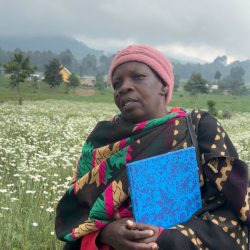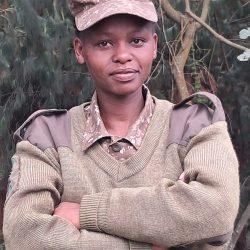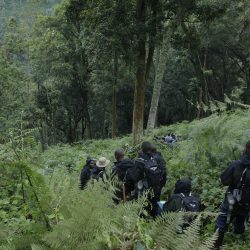Human Wildlife Conflict Measures Restore Hope for better harvest for park edge communities in Rwanda and DRC
Blog | 15/11/20
Regardless of the scotching sun and laborious work, a delighted face is the perfect description of Jean Bosco Ntawukibiwabo, as he worked on a three metres deep trench at the boundary of Volcanoes National Park in Bugeshi sector, Rubavu district. The trench is an extension of the buffalo wall built around the Volcanoes National Park perimeter to prevent problem animals especially buffalos from crossing over to neighboring gardens to raid crops. Bugeshi sector is a transboundary area adjacent to both Volcanoes National Park in Rwanda and Virunga National Park in DRC. Just like other park edge communities, the community in Bugeshi is challenged by problem animals, however human wildlife measures such as the trench and buffalo wall are helping to address the conflict.
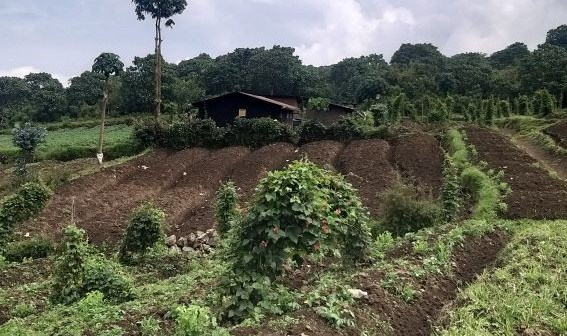
“I wouldn’t know the right words to describe how much this trench has contributed to better harvest and household income. With the trench in place our crops are now safe from problem animals that used to destroy them ,”narrates Jean Bosco. Jean Bosco recalls the ordeal of having to invest in farming but yield almost nothing. Several years back, buffalos raided and destroyed his irish potato farm; where he expected a harvest of one and a half tones Jean Bosco only harvested 500 kilograms which could not even sustain his family.
Inaugurated in 2004 by IGCP in collaboration with park staff and local communities, the one metre high and 76 Km long dry-stone buffalo wall was established as a solution to address Human Wildlife Conflict in the area,then the trench was dug by local conservation associations. Currently IGCP is working with transboundary local communities in Bugeshi –area and Cyanika in Musanze District to renovate 7 kms of the buffalo wall and trench to ensure that the HWC gains are sustained. The trench will be increased in length to between 2.5 to 3 metres high to minimize any chances of buffalos crossing over from the parks into the neighbouring gardens.
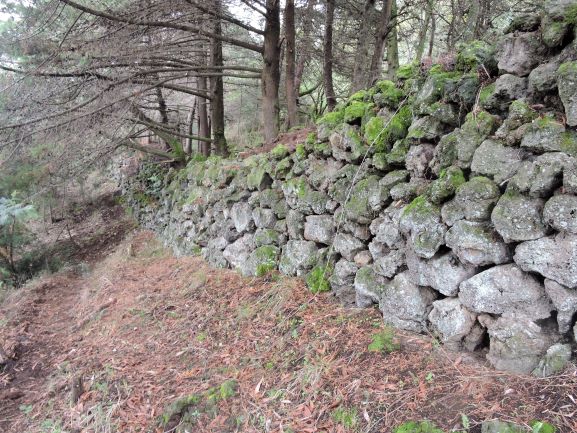
“With such initiatives in place, HWC will be reduced and communities will be more aware of their role in the sustainability and protection of the parks and ensuring good co-existence,” says Benjamin Mugabukomeye, IGCP Rwanda Country Coordinator.
The buffalo wall and trench maintenance work is being done by members of the local community working under 14 conservation cooperatives including a few extremely poor people selected from the society according to their social status , at a small fee. Members of the cooperatives reveal that the wages earned from this exercise helped them to buy food and basic needs for their families for a while. “Every worker earnsed Rwf 1500 per day, this money has not only helped cooperative members to take care of their essentials but also poor people to afford basics like paying for the community based health insurance and renovating their pit latrines,” says Venuste Ndacayisenga, a member of a Land conservation cooperative (KOSUBU) working on the trench.
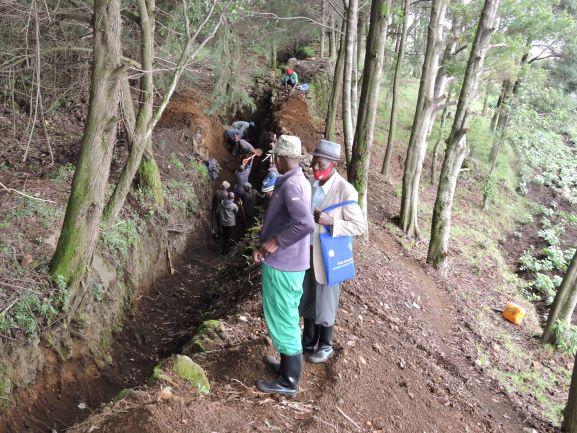
To ensure its effectiveness, the trench is routinely maintained by the community members during their monthly communal work locally known as Umuganda. Regular maintenance helps to monitor and patch possible animal escape points usually created by the heavy rains and floods.
Commenting on the relevance of the existing HWC measures to the community, Jean Bosco reveals that the local communities are grateful to IGCP and the park for their effort in addressing HWC in the area. Jean Bosco adds that several people who had lost hope in farming have since been motivated afresh to farm even closer to the park boundary and are optimistic for better yields.
Sharing with the community members of Bugeshi it is clear that the buffalo wall and trench have played a key role in managing problem animals, minimizing crop raiding incidences, increasing crop yields and repairing park – community relations.
Meanwhile Virunga National Park along with park edge communities in transboundary areas of Kibumba in DRC and Bugeshi in Rwanda also successfully erected an electric fence to enforce Human Wildlife Conflict management. The 2.5 metre high fence will cover an area of 3.5 kilometers along the Virunga National Park perimeter and act as a barrier against problem animals and it is an extension of the already existent 100km electric fence around the Virunga National Park.
Such measures improve human-wildlife co-existence and are practical ways to protect wildlife.

